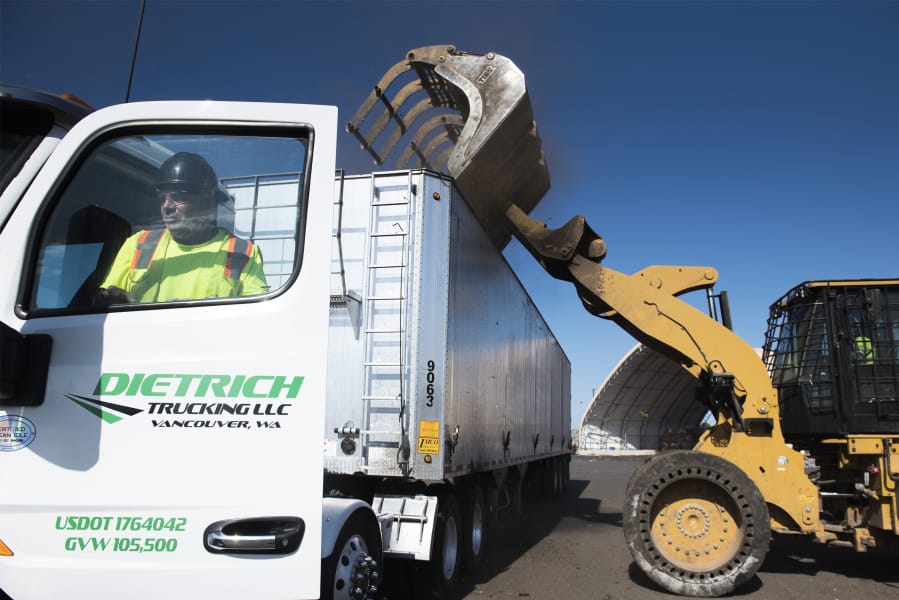The gray, gloppy sludge doesn’t resemble food, except for the specks of color from discarded fruits and vegetables.
The unsightly goo, dumped along one side of the main building at West Vancouver Materials Recovery Center and covered in dust and grime from garbage operations, is food waste.
Waste Connections, which provides garbage and recycling services to most of Clark County, collects food scraps and debris from businesses and schools each weekday and sends it via a contract trucking firm to Dirt Hugger, a composting business in Dallesport, about 90 miles east of Vancouver.
Removing food waste from garbage is one way to preserve valuable landfill space and turn unwanted refuse into high-quality compost.
Did You Know?
• In 2015, the U.S. disposed of 37.6 million tons of wasted food.
• Ninety-four percent of wasted food ends up in landfills or incinerators.
• Food scraps and yard debris accounts for about 30 percent of what Americans throw away.
Source: U.S. Environmental Protection Agency
Beginning Sept. 30, the amount of food waste arriving at the transfer station will increase as Waste Connections allows single-family residential customers inside Vancouver city limits to add food scraps to their teal-colored yard-debris carts.
“We’re excited to roll the program out,” said Derek Ranta, district manager for Waste Connections. “It’s something we have been talking about a long time.”
Starting the week of Sept. 16, Waste Connections will deliver pails for food scraps to yard-debris customers in Vancouver at no cost.
The pails are similar to what most backyard composters already use in their kitchens. After receiving pails, customers can start dumping food waste from the pails into their yard-debris carts for their next every-other-week collection.
Waste Connections and the city of Vancouver have rebranded the program as organics. About 60 percent of single-family customers in Vancouver already have yard-debris collection, which is an optional service, unlike mandatory garbage and recycling pickup.
“We’ve had a pretty good diversion of yard debris,” said Rich McConaghy, environmental resources manager for Vancouver Public Works. “As other things have been recycled, food becomes a bigger share of what’s left over.”
McConaghy said the food-waste program was included in the solid-waste contract the Vancouver City Council approved earlier this year. Schoolchildren have been sorting their food waste for years, he said.
“This will give the kids a chance to practice at home what they have done at school,” he said. “It will be turned into high-quality, nutrient-rich compost that will make farms and gardens grow.”
For 10 years, Waste Connections has picked up food waste from participating businesses and schools. Every afternoon on weekdays, a contract driver pulls into the west transfer station. First, a layer of yard debris is dumped into the bottom of his trailer, followed by the food waste and a second layer of yard debris.
Ranta said Waste Connections creates what he called “an Oreo” of organic waste for two reasons. The transfer station handles between 7 and 10 tons of food waste a day, not enough to fill a trailer. The food waste tends to be “juicy,” and the yard debris soaks up the excess liquid.
Ranta isn’t sure how much food waste will begin flowing into the west transfer station, where it will be quickly moved off site, typically daily but within 72 hours for material arriving late Friday.
“It’s more kind of along the lines of ‘We will know it when we get it,’ ” Ranta said. “Every demographic is so different, and every program is so different.”
What is food waste?
Food waste is discarded during meal preparation or scraped off plates following meals. It includes produce, bread, cereals, coffee grounds, egg shells, cheese, meat, bones, and clam and oyster shells.
Food waste does not include ashes, dead animals, oil and other liquid waste, pet excrement, kitty litter and compostable service ware. Those items should be disposed of as garbage.
“Often compostable means compostable plastic,” McConaghy said. “Dirt Hugger doesn’t want any of that material.”
The program that will launch in 30 days is not open to garbage-recycling customers outside Vancouver. Those customers should continue putting food waste into their garbage cans or backyard composting containers or piles.
Not sure if you live inside the Vancouver city limits? Vancouver has an online map, www.cityofvancouver.us/ourcity/page/do-you-live-or-work-city-vancouver, that allows you to enter your address and determine if you are a city resident.
Ranta said Waste Connections’ drivers will be watching to see if customers outside Vancouver start dumping food waste in their yard-debris carts. Drivers will open lids to peek inside and will use cameras to check as carts are emptied into their trucks, he said.
“They would be tagged and refused for service,” Ranta said about customers outside Vancouver brazenly mixing food and yard waste. “During the rollout, in particular, we are going to be strict about that.”
Ranta said yard debris collected by his company typically is sent to H&H Wood Recyclers, Triangle Resources or another local company, where it is pulverized and used as “hog fuel” to power industrial boilers.
These companies, he said, are not permitted to handle food waste, which is why mixed loads of yard debris and food waste will be trucked to Dirt Hugger.
“Once you add food waste, it becomes a different kind of waste,” said Travis Dutton, solid waste program manager with Clark County Public Health.
Dutton said there currently isn’t enough capacity to collect food waste produced by county residents living outside Vancouver.
“We have the ability to pick it up from homes,” he said. “We don’t have a place to put it.”
Dutton said there are examples where the city and county have different programs for food waste. The city of Tacoma has a food-waste program while Pierce County does not, he said.
There is one drawback to Vancouver having food-waste collection. On-call service, where residents can have their yard debris picked up as needed instead of every other week, will no longer be offered inside the city limits because of health concerns over storing food waste for longer than two weeks.
2019 legislation
On May 7, Gov. Jay Inslee signed legislation the House and Senate unanimously approved setting a goal to reduce the amount of food waste in Washington by 50 percent before 2030, based on 2015 levels. The legislation also requires the Washington State Department of Ecology to develop a “state wasted food reduction and food waste diversion plan” by October 2020.
Dutton said it’s not entirely clear how the 50 percent reduction will be accomplished.
“A lot of waste happens before it even gets to our home,” he said. “I think there are a lot of questions that are unanswered.”
One approach is to focus on preventing food waste instead of finding ways to reuse wasted food.
According to the Environmental Protection Agency, 31 percent of the nation’s fresh tomatoes are thrown out, the equivalent of 21 tomatoes annually for every American. Those wasted tomatoes cost more than $2.3 billion a year.
“Food waste, from our standpoint, makes up about 20 percent of what is thrown away in our garbage cans,” Dutton said. “Each resident in Clark County throws about 1 pound of food a day into the garbage.”
McConaghy agreed that prevention needs to be part of any food-waste program.
“If you prevent food waste, you are reducing the chemicals and the energy and the water and everything that went into producing that food,” he said.




